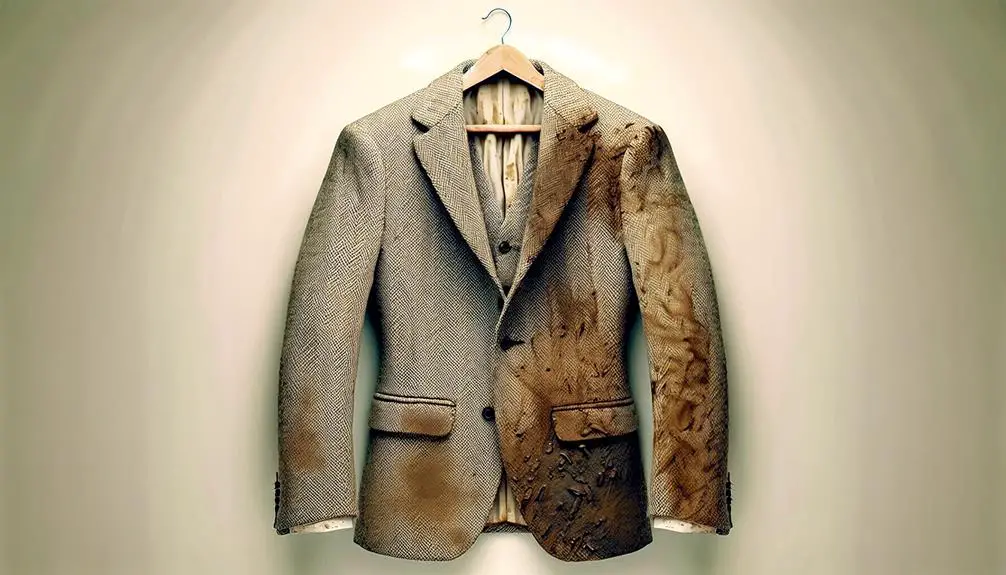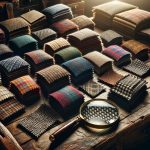I've always wondered about tweed's reputation for durability and whether it really holds up when it comes to getting dirty. From its woolen weave to its often multicolored appearance, tweed seems like it could be a champ at hiding everyday stains and spills. But do different weaves and lighter colors affect how much dirt it actually attracts? Let's explore if tweed's practical charm really extends to its maintenance, and whether this beloved fabric is as easy to care for as it is stylish. What do you think, does tweed resist dirt or does its textured surface catch more than we realize?
Table of Contents
Key Takeaways
- Tweed's tight weave repels soil, reducing the frequency of washing needed.
- Darker colors and complex patterns in tweed help hide stains and dirt.
- Loose weave tweed varieties may trap more dirt, requiring more frequent cleaning.
- Water-resistant treatments on tweed enhance its resilience against dirt and stains.
- Regular brushing and proper storage contribute to keeping tweed cleaner for longer.
Understanding Tweed's Composition
Tweed is a durable, woven fabric typically made from wool, often featuring a textured, multicolored appearance. Let's explore its composition to truly grasp why it's so esteemed. Tweed's primary fiber, wool, is sourced mainly from sheep. This natural fiber is essential to tweed's robustness and aesthetic appeal. Depending on the tweed type, other fibers like silk or synthetic blends are sometimes introduced to achieve different textures or durability levels.
The material origin plays a significant role in tweed's characteristics. For instance, Harris Tweed, exclusively made from pure virgin wool dyed and spun in the Outer Hebrides of Scotland, is known for its exceptional quality and resilience. The geographical and climatic conditions where the wool is harvested influence the fiber's properties, such as its fineness, strength, and how it reacts to dyeing processes.
Understanding these elements—the fiber types and material origin—is vital for anyone looking to master the nuances of tweed. Each component contributes to the fabric's unique feel, look, and longevity. So, when you pick up a tweed garment, you're not just wearing a piece of fabric; you're wearing a rich blend of nature's best, crafted with artisanal precision.
Weave Density and Dirt Resistance
Now, let's talk about how the density of tweed's weave affects its ability to resist dirt.
If the weave is tight, it tends to repel soil much better, keeping the fabric cleaner.
On the other hand, a looser weave might trap more dirt, which means it'll get dirty quicker.
Tight Weaves Repel Soil
One often overlooks how tightly woven fabrics, like certain tweeds, naturally resist dirt and stains. It's all in the weave density; the tighter the weave, the less space for dirt to infiltrate. This quality makes tweed a vital choice for clothing that not only lasts but also maintains a clean appearance with less effort. Understanding these fabric characteristics is essential when selecting garments that require minimal maintenance.
When it comes to cleaning methods, tight-weave tweeds are less of a hassle. They typically need less frequent washing, which in turn preserves the fabric's integrity longer. Just a quick brush or a wipe down often suffices, saving you time and keeping those professional or rustic looks spot-on.
Loose Weaves Trap Dirt
Contrastingly, loose tweed weaves often trap more dirt due to their spacious fiber arrangements. This structure, while enhancing fabric breathability, unfortunately makes it easier for dirt particles to settle within the fibers, leading to quicker dirt accumulation.
Here's a quick table comparing characteristics of tight and loose tweed weaves:
| Aspect | Tight Weave | Loose Weave |
|---|---|---|
| Dirt Accumulation | Less prone | More prone |
| Fabric Breathability | Lower | Higher |
| Cleaning Frequency | Less Frequent | More Frequent |
| Durability | Generally higher | Varies |
| Aesthetic & Texture | Smoother finish | More textured finish |
As you can see, choosing between tight and loose weaves depends on your preference for breathability versus ease of maintenance.
Influence of Tweed Colors
While darker tweed colors hide stains and dirt better, lighter shades may show soiling more quickly. That's a pretty straightforward concept, right? It's all about how visible the dirt appears, not necessarily how much dirt the fabric actually holds. If you're like me and you tend to spill coffee now and then, opting for a darker tweed might save you some stress.
But let's dive a bit deeper into color psychology and pattern perception. Dark colors not only conceal stains; they also tend to give off a vibe of sophistication and durability. Think about it—when you see someone in a dark tweed jacket, isn't there an instant impression of rugged elegance? On the other hand, lighter colors can appear more casual and approachable, but they mightn't fare well in a mud-splattered situation.
The visibility of soiling in tweed also depends on the pattern. A complex herringbone or check can cleverly disguise marks and smudges, much better than a solid, light color. It's all about how the eye perceives these patterns. With a busy pattern, your focus is disrupted, and it's harder to spot a specific stain compared to a plain fabric. So, choosing the right color and pattern can really influence how often you'll need to clean your tweed gear.
Common Uses of Tweed
Tweed is commonly chosen for jackets and coats due to its durability and style. It's not just about staying warm; the fabric's unique texture and variety of tweed patterns make it a staple in fashion. I've seen tweed used in everything from classic blazers to trendy caps, blending tradition with modern flair.
Beyond outerwear, tweed finds its way into pants and skirts, especially in fall and winter collections. Seasonal trends often dictate the colors and patterns you'll see. For instance, earthy tones dominate in autumn, while brighter, pastel-infused tweeds pop up in spring collections. This adaptability makes tweed a go-to for designers aiming to balance comfort with sophistication.
Accessories haven't escaped the tweed treatment either. Bags, shoes, and even home décor items like cushions and throws often feature tweed, proving its versatility. It's not uncommon for me to spot a chic, tweed-covered ottoman in a stylish boutique or a set of tweed throw pillows adding texture to a minimalist couch setup.
Maintenance Tips for Tweed
I often find that maintaining tweed is simpler than you might expect. Let's explore some foolproof tips to keep your tweed looking great without much fuss.
First off, dry cleaning is your best friend when it comes to tweed. This fabric thrives with professional care, as it guarantees the fibers aren't subjected to harsh treatments that typical washing machines might impose.
When it's just a minor blemish, spot treatment works wonders. I use a soft cloth dipped in mild soapy water to dab at any stains. It's important to blot rather than rub to avoid damaging the fabric's surface. Always test this on an inconspicuous area first to make sure there's no discoloration or fiber damage.
For daily maintenance, I recommend a soft-bristled brush. Brushing your tweed regularly not only removes surface dirt and lint but also helps maintain its iconic texture. If you're storing tweed, make sure it's in a breathable garment bag in a cool, dry place to prevent mustiness.
Comparing Tweed With Other Fabrics
Let's compare tweed to other popular fabrics to see how it stacks up when it comes to durability and maintenance. Tweed, a traditionally wool-based fabric, is renowned for its resilience and ability to withstand wear and tear. It's quite different from lighter materials like cotton or silk, which may not hold up as well under similar stress.
When considering fabric breathability, tweed is less breathable than cotton, but more so than synthetic fabrics like polyester. This characteristic makes tweed a solid choice for cooler weather, keeping you warm without trapping too much heat. In contrast, cotton shines in warmer climates due to its superior breathability and moisture-wicking properties.
Moving on to a cost comparison, tweed generally falls on the pricier side, especially if you're eyeing authentic, high-quality variants. Cotton and synthetic fabrics are usually more wallet-friendly, making them more accessible but often sacrificing durability and unique textures that tweed offers.
In essence, if you're after a fabric that balances durability with a classic aesthetic, tweed is worth the investment. However, for everyday wear in varied climates, lighter and more breathable fabrics might be more practical, depending on your needs and budget.
The Role of Protective Treatments
Now let's talk about how protective treatments can help keep your tweed looking fresh.
Water-resistant coatings and stain repellent applications can really make a difference.
They help your tweed resist dirt and spills, making maintenance a breeze.
Water-Resistant Coatings
Water-resistant coatings can greatly enhance tweed's resilience against dirt and stains. When I investigate how these coatings work, it's all about the chemical interactions between the coating materials and the tweed fibers. These interactions create a barrier that repels water and prevents dirt from embedding in the fabric.
The key to maximizing effectiveness lies in the application methods. Spraying or dipping the tweed in these protective solutions guarantees a uniform coat that covers all nooks and crannies. However, it's vital to apply these coatings correctly. A patchy application won't just look uneven; it'll leave parts of the tweed vulnerable to dirt and moisture, which pretty much defeats the purpose of going through the trouble in the first place.
Stain Repellent Applications
Moving beyond water resistance, stain repellent applications play an essential role in protecting tweed from more stubborn blemishes. These treatments, often made up of chemical additives, aren't just slapped on; they're carefully integrated to maintain the fabric's breathability and texture.
I've found that this balance is vital. Too much coating, and the fabric feels stifling. Too little, and it's like you've got no shield at all.
Everyday Care Practices
How do we keep tweed looking its best with simple everyday care practices? First off, let's talk about fabric softeners. You might think they're a go-to for keeping fabrics soft and manageable, but for tweed, they're a big no-no. Tweed thrives with less chemical interference, so skipping the softener actually preserves the fabric's natural resilience and texture.
When it comes to ironing techniques, there's a right and a wrong way to do it. Always use a pressing cloth between the iron and the tweed to avoid direct contact, which can scorch or flatten the rich texture of the fabric. Set your iron on a low to medium heat, and don't press too hard. Gentle steam can help to smooth out wrinkles without crushing the fibers.
Daily, I give my tweed items a good shake before hanging them up. This simple action helps dislodge any surface dirt and prevents the fibers from becoming matted. For those who wear tweed regularly, rotating your garments allows them to rest and regain their shape, reducing the need for frequent cleaning and prolonging the fabric's life and appearance.
Longevity and Aesthetic Appeal
Let's talk about how well tweed holds up and how it looks as it ages.
I've noticed that its durability really stands out; it doesn't just wear down easily.
However, it does change visually over time, which can be both a pro and a con depending on your style.
Durability of Tweed
Tweed's durability and timeless appeal guarantee it remains a popular choice for long-lasting fashion. Its robustness isn't just about looking great; it's about crafting an enduring piece of clothing that stands up to daily wear and tear.
Here's why Tweed is a go-to for anyone seeking durability:
- Tweed Weight: Heavier tweeds are particularly resilient, offering more protection and lasting longer than lighter versions.
- Fiber Origin: The quality of the fibers, often sourced from specific breeds of sheep, plays an essential role in the toughness of the fabric.
- Tight Weave: The dense weave of tweed fabrics prevents easy tearing and withstands rugged use.
- Natural Resilience: Wool, the primary component of tweed, has natural properties that resist wear and deformation.
Visual Changes Over Time
Over time, tweed develops a unique patina that enhances its aesthetic appeal without compromising its longevity. As I've worn my tweed pieces, I've noticed subtle changes that add character.
Color fading, for instance, isn't as pronounced as you might expect. It occurs gently, giving the fabric a gracefully aged look rather than a worn-out appearance.
Similarly, pattern distortion is minimal. The intricate weaves hold their ground pretty well, maintaining the integrity of the original design even after several wears and washes. This resilience against visual wear not only speaks to the quality of tweed but also reassures you that investing in a good tweed piece means you're getting both style and durability.
Professional Cleaning Recommendations
How should you approach professional cleaning for your tweed garments? Well, it's not as complicated as you might think, but it does require some know-how to make sure your clothes stay in excellent condition. Here's my go-to list for handling professional cleaning:
- Choose the Right Dry Cleaner: Not all dry cleaners are created equal, especially when it comes to handling tweed. Look for someone experienced with wool and tweed fabrics. They'll use the right dry cleaning methods that are gentle yet effective.
- Discuss Spot Treatment Options: Before you hand over your tweed, discuss any stains with your cleaner. They should know the best spot treatment options to use that won't damage the fabric or alter its appearance.
- Frequency of Cleaning: Don't overdo it. Tweed doesn't need to be cleaned too often. I usually send my tweed items for cleaning once a season unless there's a noticeable stain or odor.
- Inspect After Cleaning: Always check your garment after it's been cleaned. Make sure there are no harsh chemicals left behind or any texture changes. This way, you catch any issues before they become significant problems.
Following these steps, I've managed to keep my tweed collection in excellent condition, and you can too!
Frequently Asked Questions
Can Tweed Be Dyed at Home Safely?
Yes, I've successfully dyed tweed at home using proper dyeing techniques to guarantee color retention. It's essential to follow specific fabric care instructions to prevent damaging the material during the dyeing process.
Is Tweed Appropriate for Summer Wear?
I wouldn't recommend tweed for summer wear; it lacks fabric breathability. Although its style versatility is appealing, you'd likely feel overheated in warmer weather due to its typically heavy and dense weave.
Are There Hypoallergenic Tweed Options Available?
I've found that hypoallergenic tweed options do exist! They're often treated to reduce fabric allergies. It's worth checking the specific treatments applied to make sure they meet your needs for allergy-friendly clothing.
How Does Tweed React to Humidity?
Tweed reacts to humidity by absorbing moisture, which can affect its durability. I've noticed it holds up fairly well, though, especially if it's high-quality. Just keep it dry and air it out regularly!
Can Tweed Garments Be Ironed Directly?
You shouldn't iron tweed garments directly due to their texture. Instead, use a pressing cloth and low heat settings. Exploring ironing alternatives like steaming can also prevent damage and maintain their appearance.
- Does Tweed Get Dirty Easily? - April 24, 2024
- When Should You Wear Tweed? - April 24, 2024
- How Formal Is Tweed? - April 24, 2024








